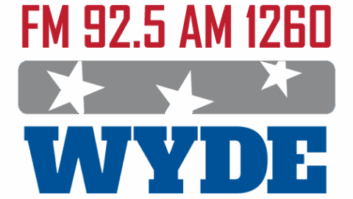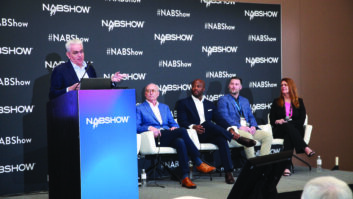
David Layer speaks at the NAB Show. Photo by Jim Peck
One in a series of articles exploring news developments at the recent NAB Show.
More details emerged about the all-digital field tests at CBS Radio station WBCN(AM), Charlotte, N.C.
NAB Senior Director of Advanced Engineering David Layer said “solid” all-digital coverage was received, on average, out to about 40 miles daytime and 11 miles nighttime.
“It doesn’t matter which all-digital recording you’ve got. They all sound exactly the same. It’s clear to me after this test it doesn’t matter where you take the all-digital recording. It’s a noise-free signal,” he said during a session at the NAB Show, emphasizing that the results should be considered preliminary.
FCC Commissioner Ajit Pai said in a separate session he was able to listen to a test recording and that the all-digital AM audio “was incredible.”
For daytime operation, the all-digital signal was solid beyond the 1 mV/m contour, and for nighttime beyond the 5 mV/m contour.

This image is from Layer’s Broadcasting Engineering Conference presentation. He reported that the typical experience on each test route was that all-digital reception would be solid, with no dropouts, in strong signal areas near the transmit antenna, and would stay solid ‘with only an occasional dropout’ until near the all-digital point of failure, at which point reception would become intermittent and then be lost. Data from a Ford Sync receiver is shown, for daytime reception. Surprisingly, nighttime performance appeared to be compromised by the presence of co-channel interference, which was not expected on an expanded-band AM station. Layer said the team believes a nearby co-channel station may not have been fully powering down for nighttime operation.
Solid all-digital indoor reception was achieved for daytime and nighttime locations within approximately 13 and 7 miles, respectively, of the transmit antenna site.
WBCN is a 10 kW day/1 kW night non-directional expanded-band station. Its main transmitter is a Harris DX-10 fed by a Harris Dexstar exciter. As Radio World has reported, personnel from NAB, iBiquity Digital, Harris, Kintronic Labs and Meintel, Sgrignoli & Wallace participated in the testing. They drove seven routes during the day and eight at night, in a Ford Focus equipped with a Sync HD Radio receiver. They drove along each route to establish where the digital signal failed.
IBiquity Digital Field Test & Implementation Manager Russ Mundschenk said Layer rented a Ford Edge and followed behind the Focus “so we knew the radio was not impacted by the data collection.”
Testers used an Insignia Narrator HD Radio receiver to gather signal strength measurements at 15 indoor locations including steel, wood and masonry construction.
The project team is analyzing the field strength measurements and audio recordings obtained during the tests, and said it expects to make this information available to the industry when the analysis is completed.
NAB Labs is also looking for more stations for the next round of tests.
Asked whether HD Radios now in the field could decode the iBiquity all-digital signal, CBS Radio Senior Vice President of Engineering Glynn Walden said yes, except for “pocket-sized radios.”







